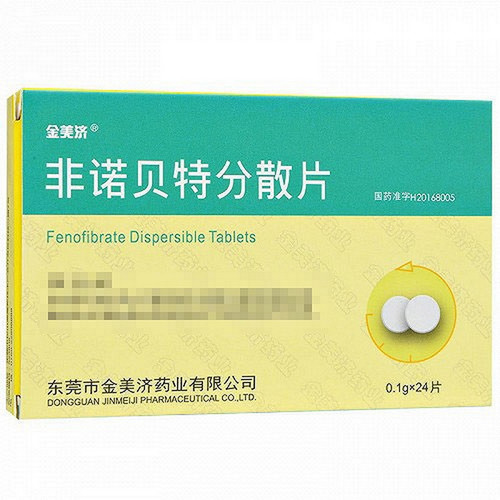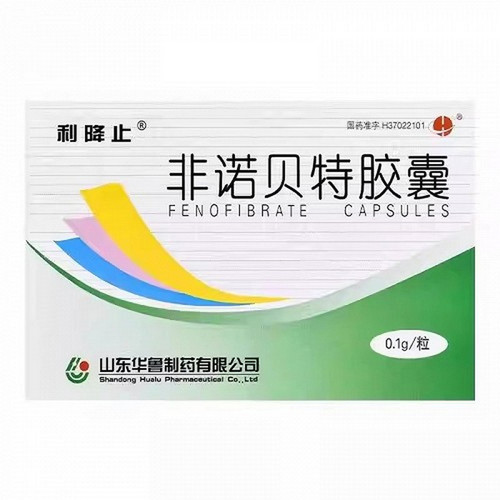Product Overview
[Drug Name]
Generic Name: Fenofibrate Tablets
Trade Name: Shuanghai Fenofibrate Tablets 0.1g*100 Tablets
Pinyin Full Code: FeiNuoBeiTePian
[Main Ingredients]
The main ingredient of this product is fenofibrate, chemically known as 2-methyl-2-(4-(4-chlorobenzoyl)phenoxy)propionic acid isopropyl ester, with a molecular formula of C20H21ClO4 and a molecular weight of 360.83.
[Properties]
This product is a white or off-white tablet.
[Indications/Main Functions]
This product is used to treat hyperlipidemia in adults who have not responded well to dietary control therapy. It has a more pronounced effect on lowering triglycerides and mixed hyperlipidemia than on cholesterol.
[Precautions]
This product may interfere with diagnosis. Taking this product may increase platelet count, blood urea nitrogen, aminotransferases, and serum calcium; and may decrease blood alkaline phosphatase, gamma-glutamyl transpeptidase, and bilirubin. During medication, regular checks should be performed: ① Complete blood count and platelet count; ② Liver function tests; ③ Blood cholesterol, triglycerides, or low-density lipoprotein cholesterol; and ④ Blood creatine phosphokinase. If clinical symptoms suggestive of myopathy (such as myalgia, tenderness, fatigue, etc.) or a significant elevation in blood creatine phosphokinase are present, medication should be discontinued. While treating hyperlipidemia, it is also important to monitor and treat underlying conditions that may contribute to hyperlipidemia, such as hypothyroidism and diabetes. Certain medications, such as estrogens, thiazide diuretics, and beta-blockers, can also cause hyperlipidemia. After discontinuation of these medications, corresponding anti-hyperlipidemic treatment is no longer necessary. Dietary therapy remains the primary treatment for hyperlipidemia, and combined with exercise and weight loss, it is superior to any other medication.
[Drug Interactions]
Fenofibrate is contraindicated in patients with a hypersensitivity reaction and in patients with a history of gallbladder disease or cholelithiasis. This medication can increase cholesterol excretion into bile, leading to gallstones. This product is contraindicated in patients with severe renal insufficiency, hepatic insufficiency, primary biliary cirrhosis, or persistent liver dysfunction of unknown cause.
[Specifications]
0.1g x 100 tablets
[Dosage and Administration]
The usual adult dose is 0.1g orally three times daily, with a maintenance dose of 0.1g once or twice daily. To minimize gastric discomfort, this product can be taken with food. The dosage should be reduced in patients with renal insufficiency and the elderly. Discontinue the product if no effect is seen after two months of treatment.
[Adverse Reactions]
The incidence is approximately 2%-15%. Gastrointestinal reactions include abdominal discomfort, diarrhea, and constipation, most commonly (approximately 5%); rash (2%); and neurologic adverse reactions include fatigue, headache, loss of libido, impotence, dizziness, and insomnia (approximately 3%-4%). This product, a clofibric acid derivative, may cause myositis, myopathy, and rhabdomyolysis, leading to elevated blood creatine phosphokinase. Rhabdomyolysis, primarily manifesting as myalgia combined with elevated blood creatine phosphokinase and myoglobinuria, can rarely lead to renal failure. The risk of myopathy is increased in patients with nephrotic syndrome and other renal impairment leading to hypoalbuminemia, or in patients with hyperthyroidism (approximately 1%). It has a tendency to increase the risk of gallstones and may cause gallbladder disease, which may require surgery. Mild to moderate hematologic changes may occur in the early stages of treatment, such as decreased hemoglobin, hematocrit, and white blood cell count, and occasionally elevated blood aminotransferases, including alanine and aspartate aminotransferase.
[Contraindications]
Fenofibrate is contraindicated in patients allergic to it; those with a history of gallbladder disease or cholelithiasis. This drug can increase cholesterol excretion into bile, leading to gallstones. It is also contraindicated in patients with severe renal insufficiency, hepatic insufficiency, primary biliary cirrhosis, or persistent liver dysfunction of unknown cause.
[Pharmacology and Toxicology]
This drug is a clofibric acid derivative that lowers blood lipids by inhibiting the production of very low-density lipoprotein (VLDL) and triglycerides while simultaneously increasing their catabolism. It also increases the production of apolipoproteins A1 and A11, thereby increasing high-density lipoprotein (HDL). This drug also has the effect of lowering serum uric acid in healthy individuals and patients with hyperuricemia. Animal studies have shown that fenofibrate is teratogenic and carcinogenic.








